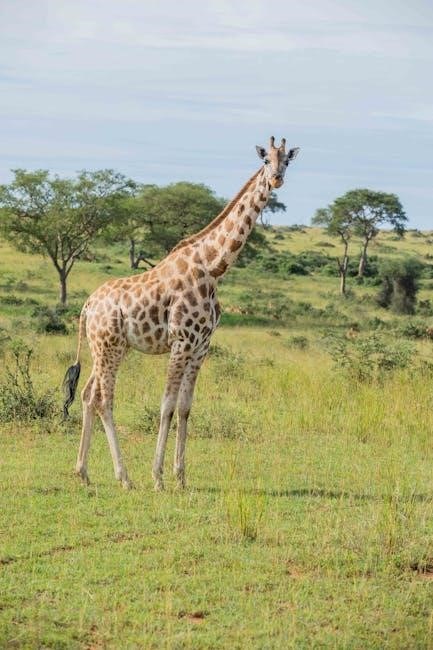Understanding Biology PDF: A Comprehensive Guide
Embark on a journey through life’s intricacies! This guide explores biology’s core themes, from cellular mechanisms to ecosystems. Grasp key concepts through detailed explanations and illustrative examples. Enhance your scientific skills and understanding.

Major Themes in Biology
Biology, the science of life, encompasses several unifying themes that provide a framework for understanding the complexity and diversity of the living world. These themes highlight the interconnectedness of biological systems and processes, from the smallest molecules to entire ecosystems. Evolution, a fundamental concept, explains the unity and diversity of life, showcasing how organisms change over time through natural selection. The flow of information, particularly genetic information, is crucial for the continuity of life, governing inheritance, development, and cellular function. Structure and function are intricately linked at all levels of biological organization, where form dictates how a biological component works. Energy transfer and transformations are essential for life processes, as organisms acquire, convert, and utilize energy to maintain order and carry out activities. Homeostasis, the maintenance of a stable internal environment, is vital for survival, enabling organisms to regulate their physiological processes in response to changing conditions. Interconnections within biological systems are pervasive, demonstrating how organisms interact with each other and their environment in complex webs of relationships. These themes collectively provide a comprehensive understanding of biology, highlighting the principles that govern all living things and their interactions with the world around them, emphasizing the importance of studying life from multiple perspectives. Understanding these major themes allows us to see the big picture and appreciate the elegance and efficiency of biological systems. From the microscopic realm of molecular interactions to the vast expanse of ecological relationships, biology reveals the interconnectedness of all life on Earth. This holistic view fosters a deeper appreciation for the delicate balance of nature and the importance of preserving biodiversity.
Characteristics Defining Life

Defining life is a complex challenge, yet several key characteristics distinguish living organisms from non-living matter. Organization is a fundamental aspect, as living things exhibit a high degree of order, from the arrangement of atoms into molecules to the organization of cells into tissues, organs, and systems. Metabolism, the sum of all chemical processes within an organism, is essential for acquiring and using energy to sustain life. Growth and development are characteristic of living organisms, involving an increase in size and complexity over time, guided by genetic information. Reproduction is the ability to produce offspring, ensuring the continuation of the species through either sexual or asexual means. Response to stimuli is another defining trait, enabling organisms to react to changes in their environment, such as light, temperature, or chemicals. Adaptation is the process by which organisms evolve over time to better suit their environment, through the accumulation of favorable traits passed on to future generations. Homeostasis, the maintenance of a stable internal environment, is crucial for survival, allowing organisms to regulate factors such as temperature, pH, and water balance. Heredity, the transmission of traits from parents to offspring through genes, ensures the continuity of life and the inheritance of characteristics. Cellular organization is a universal characteristic, as all living things are composed of one or more cells, the basic units of life. These characteristics collectively define life, distinguishing living organisms from non-living matter and highlighting the unique properties that enable them to thrive in diverse environments. Understanding these defining traits is essential for comprehending the complexity and diversity of the living world.

Levels of Biological Organization
The study of biology involves examining life at various levels of organization, each building upon the previous one. At the simplest level is the atomic level, where atoms, the fundamental units of matter, combine to form molecules. These molecules, such as proteins, carbohydrates, lipids, and nucleic acids, are the building blocks of cells. The cellular level represents the basic unit of life, where organelles, specialized structures within cells, carry out specific functions. Similar cells are organized into tissues, such as muscle tissue, nervous tissue, epithelial tissue, and connective tissue, which perform specific tasks within the body. Different tissues are then organized into organs, such as the heart, brain, or liver, which perform more complex functions. Multiple organs working together form organ systems, such as the digestive system, respiratory system, or circulatory system, which carry out major bodily functions. Organisms, individual living entities, are composed of interacting organ systems. Populations consist of all the individuals of a species living within a specific area. Communities encompass all the interacting populations of different species within a given area. Ecosystems include the community of organisms along with the non-living environment, such as air, water, and soil, with which they interact. The biosphere represents the highest level of organization, encompassing all of Earth’s ecosystems and the interactions between them. Understanding these levels of biological organization is crucial for comprehending the complexity and interconnectedness of life, from the smallest molecules to the entire planet. Each level builds upon the previous one, creating a hierarchical structure that governs the functioning of living systems.
Information Transfer Mechanisms

Information transfer is a fundamental process in biology, crucial for maintaining life’s functions and ensuring continuity across generations. At the core of this process is DNA, deoxyribonucleic acid, which carries the genetic blueprint of an organism. DNA’s information is encoded in the sequence of its nucleotide bases, adenine (A), guanine (G), cytosine (C), and thymine (T). This genetic information is transcribed into RNA, ribonucleic acid, through a process called transcription. Messenger RNA (mRNA) carries the genetic code from the nucleus to the ribosomes in the cytoplasm, where protein synthesis occurs; Transfer RNA (tRNA) molecules bring specific amino acids to the ribosome, matching them to the mRNA codons, which are three-nucleotide sequences that specify particular amino acids. Ribosomes then catalyze the formation of peptide bonds between amino acids, creating polypeptide chains that fold into functional proteins. These proteins carry out a vast array of functions within the cell, including catalyzing biochemical reactions, transporting molecules, and providing structural support. Information transfer also occurs through cell signaling pathways, where cells communicate with each other by releasing signaling molecules, such as hormones or neurotransmitters. These molecules bind to receptors on target cells, triggering intracellular signaling cascades that alter gene expression or cellular activity. In multicellular organisms, the nervous system plays a critical role in information transfer, using electrical and chemical signals to transmit information rapidly throughout the body; Furthermore, genetic information is passed from parents to offspring through reproduction, ensuring the inheritance of traits and the continuation of life. Understanding these information transfer mechanisms is essential for comprehending how organisms develop, function, and evolve. Disruptions in these processes can lead to various diseases and disorders, highlighting the importance of maintaining proper information flow within biological systems.
Energy Flow in Biological Systems
Energy flow is a critical aspect of biological systems, governing how organisms obtain, convert, and utilize energy to sustain life processes. The primary source of energy for most ecosystems is the sun. Photosynthetic organisms, such as plants, algae, and some bacteria, capture solar energy through photosynthesis. During photosynthesis, light energy is converted into chemical energy, stored in the form of glucose and other organic molecules. These organisms are known as producers, forming the base of the food chain. Herbivores, or primary consumers, obtain energy by consuming producers. Carnivores, or secondary and tertiary consumers, obtain energy by consuming other animals. Omnivores consume both plants and animals. At each trophic level, energy is lost as heat during metabolic processes, such as respiration and movement. This energy loss limits the length of food chains, as there is progressively less energy available at higher trophic levels. Decomposers, such as bacteria and fungi, break down dead organisms and organic waste, releasing nutrients back into the environment. These nutrients are then used by producers, completing the cycle. Energy flow can be represented by ecological pyramids, which illustrate the relative amounts of energy, biomass, or numbers of organisms at each trophic level. The first law of thermodynamics, the law of conservation of energy, states that energy cannot be created or destroyed, but only converted from one form to another. The second law of thermodynamics states that during energy conversions, some energy is always lost as heat, increasing entropy or disorder in the system. Biological systems maintain order by constantly requiring an input of energy. Understanding energy flow is crucial for comprehending ecosystem dynamics, nutrient cycling, and the interactions between organisms. Disruptions to energy flow, such as pollution or habitat destruction, can have cascading effects throughout the entire ecosystem, impacting biodiversity and ecosystem stability. Therefore, conserving energy resources and promoting sustainable practices are essential for maintaining healthy and resilient biological systems.
Evolution as a Unifying Concept
Evolution serves as the cornerstone of modern biology, providing a framework for understanding the diversity and unity of life on Earth. It explains how species change over time through the process of natural selection, where organisms with advantageous traits are more likely to survive and reproduce, passing those traits on to their offspring. These advantageous traits, or adaptations, arise through random genetic mutations, which are then filtered by environmental pressures. Evolution is not simply a historical process; it is an ongoing phenomenon shaping the characteristics of populations and species today. The fossil record provides evidence of past life forms and their transitions, demonstrating how species have evolved over millions of years. Comparative anatomy reveals similarities and differences in the structures of different organisms, highlighting their evolutionary relationships. Molecular biology provides further evidence for evolution, as similarities in DNA and protein sequences demonstrate common ancestry. The theory of evolution by natural selection, proposed by Charles Darwin and Alfred Russel Wallace, revolutionized our understanding of biology. It explains how populations adapt to their environments, leading to the formation of new species. Evolution accounts for the incredible diversity of life, from the simplest bacteria to complex multicellular organisms. It also explains the unity of life, as all organisms share a common ancestor and fundamental biological processes. Understanding evolution is essential for addressing many challenges facing humanity, including antibiotic resistance, emerging infectious diseases, and the conservation of biodiversity. Evolution is not a linear progression towards perfection, but rather a branching tree of life, with each species adapted to its specific ecological niche. The study of evolution encompasses various disciplines, including genetics, ecology, paleontology, and developmental biology. Evolution is a dynamic and ever-evolving field of study, constantly refining our understanding of life’s history and its future. By embracing evolution as a unifying concept, we can gain a deeper appreciation for the interconnectedness of all living things and the processes that have shaped our planet.
The Scientific Method in Biology
The scientific method is a systematic approach to understanding the natural world, and it is the foundation of biological research. It begins with observation, where scientists notice patterns or phenomena in the natural world that pique their curiosity. These observations lead to the formulation of a hypothesis, which is a testable explanation for the observed phenomenon. A good hypothesis is specific, falsifiable, and based on existing knowledge. Once a hypothesis is formulated, scientists design experiments to test its validity. Experiments involve manipulating one or more variables while controlling others to determine their effect on the outcome. The variable that is manipulated is called the independent variable, while the variable that is measured is called the dependent variable. A control group is included in the experiment to provide a baseline for comparison. Data is collected during the experiment and analyzed to determine whether the results support or refute the hypothesis. Statistical analysis is often used to assess the significance of the results. If the results support the hypothesis, it can be considered a tentative explanation for the observed phenomenon. However, it is important to note that a hypothesis can never be proven true, only supported by evidence. If the results do not support the hypothesis, it must be revised or rejected. The scientific method is an iterative process, where new observations and experiments lead to refinements in our understanding of the natural world. Scientific findings are typically published in peer-reviewed journals, where they are scrutinized by other scientists in the field. This process ensures the rigor and validity of scientific research. The scientific method is not a rigid set of rules, but rather a flexible framework that can be adapted to different research questions. It emphasizes objectivity, empirical evidence, and logical reasoning. By following the scientific method, biologists can gain a deeper understanding of the complex processes that govern life. The scientific method is essential for advancing our knowledge of biology and for addressing many of the challenges facing humanity, such as developing new treatments for diseases and understanding the impact of climate change.
